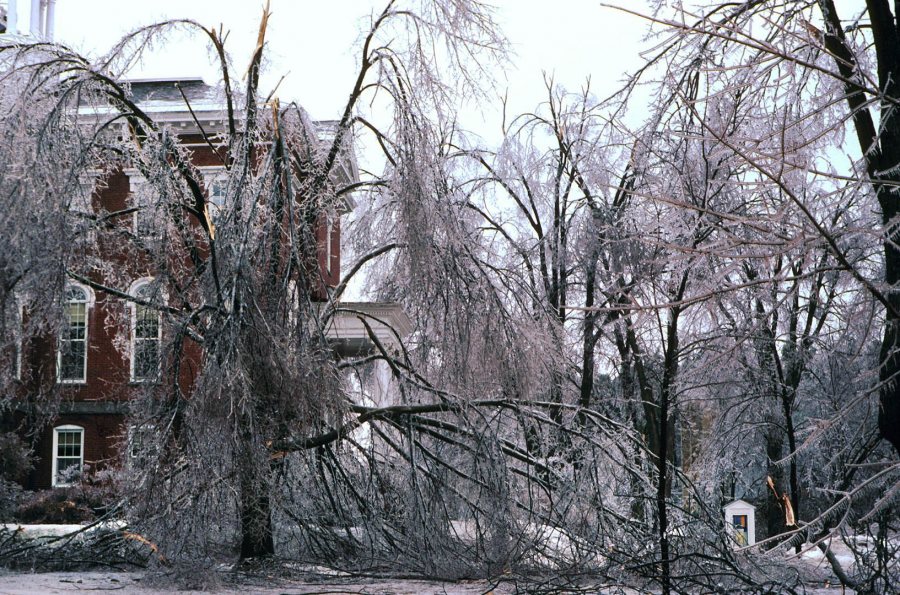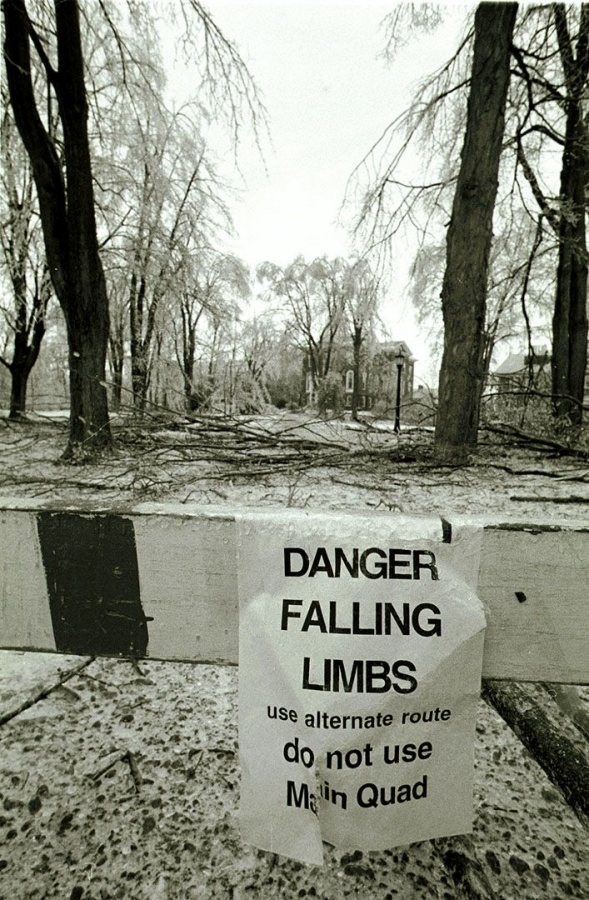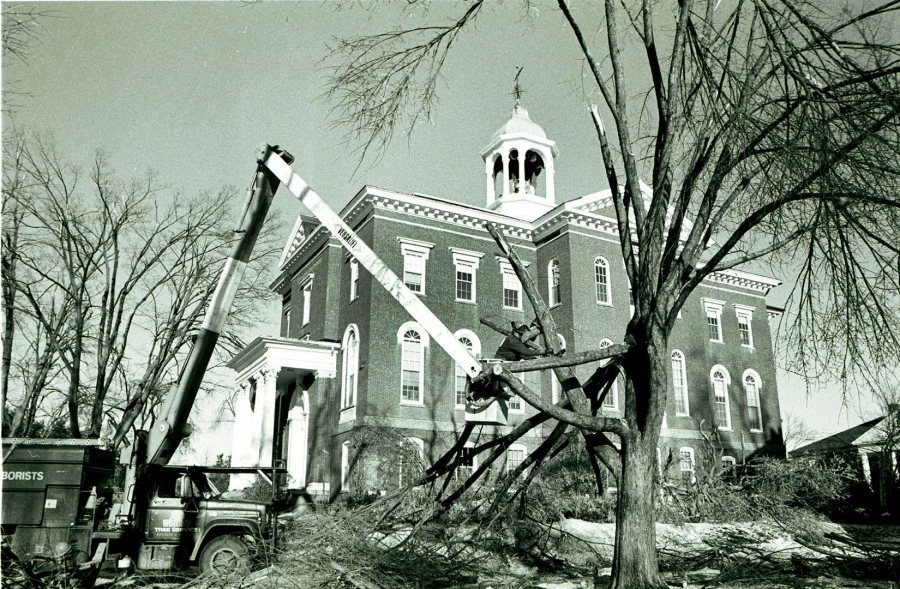
Film critic Roger Ebert, writing about the movie The Ice Storm, described the film’s icy backdrop as a “shroud of impending doom.”
At the height of the January 1998 ice storm, as tree limbs began crashing to the ground all over campus, Bates landscape architect Bill Bergevin felt the weight of that shroud. “You just wanted to yell out, ‘Stop!'” he remembers. “But you knew it wouldn’t help.”
20 Years Later
January 2018 marks 20 years since the historic and unforgettable ice storm of January 1998. To celebrate (!), we share this story from the Bates Magazine archives, published five years after the storm.
The freezing rain began on Tuesday, Jan. 6, and ended late on Friday, Jan. 9. The National Weather Service office in nearby Gray recorded about 2.5 inches of rain during the event, much of which froze on trees like transparent coats of armor.
Nearly six out of every 10 Maine residents lost electrical power during the storm. While the main Quad lost power and phone service for just Thursday and Friday, more than a few Bates faculty and staff went weeks without power at their homes.
On campus, the damage to trees was breathtaking. As the branches rained down, Bergevin had an apocalyptic thought: “I just felt there would be absolutely nothing left of our trees.”
Even just off campus, homes were without power for a week. Psychology professor John Kelsey, just two blocks from campus on Pettengill Street, had no electricity for eight days. “After six days, the pipes burst and the house was flooded,” he remembers. Still, this psych researcher had his work priorities in order: “My major concern at Bates was getting warmth to our rats in Carnegie.”
For faculty and staff without power, the campus became a beacon of normalcy. “Coming to Bates and its light and warmth was a welcome relief,” Kelsey says.
Prior to 1998, Bates had no policy for closing due to weather emergencies because, well, residential colleges simply don’t close their doors.
So, classes were held throughout the ice storm and its aftermath, and Bates’ 800 faculty and staff did what they could to get to work. One day, Elaine Freeman, now retired as associate director of Facility Services, stopped to offer a ride to Lorraine Brochu of Dining Services. En route to work, Brochu was struggling across icy Pettengill Street — on her hands and knees.
“It was too boring to stay home. No power, no lights, no nothing,” said Dining Services worker Chase Pray of Greene. “And I’m not one to stay still too long.”
Pray, a devoted runner, donned thermal polypropylene, Lycra tights, and spiked cross-country running flats and ran to work, covering nine miles of nearly impassable roads in an hour and 20 minutes.
“Work became a very real and crucial support to us,” remembers Peter Fackler, treasurer and vice president for asset management. “We commiserated, shared, and suffered together even as we battled on our own to keep life going at home and do the work necessary to keep the college functioning as well.”
Even as Bates struggled to keep going, the campus community helped the local community as it could. The Deansmen and Merimanders sang at area shelters. Responding to calls for assistance, Bates staff headed to nearby towns to check on elderly residents who had gone without heat and electricity for more than a week.
When the Red Cross contacted Associate Director for Service-Learning Peggy Rotundo for information on sources of seasoned firewood, she and husband Loring Danforth, professor of anthropology, donated half a truckload of their own supply.
On Thursday morning of the storm, Jan. 8, students, as well as faculty and staff without power in their homes, arrived for breakfast in powerless Commons. Was cold cereal on the menu? A bit of hardtack, perhaps? Hardly. Then-Director of Dining Services Bob Volpi and his staff broke out five 12-inch by 12-inch propane hot plates and cooked 2,000 two-egg omelets to order.
Volpi welcomed all Bates ice-storm sufferers to dine at Commons as long at they were without power; in the following days, a faculty group exiled from their cold houses (some just across the street from campus) gathered for meals in Commons.
Misery loves company, and the group enjoyed a spirited sense of comradeship. But soon, their numbers dwindled as power was restored. Each time the news spread (“He got power back!”), a pang ran through those left behind. “Pure envy,” remembers biologist Sharon Kinsman, who spent a couple nights sleeping in her office.
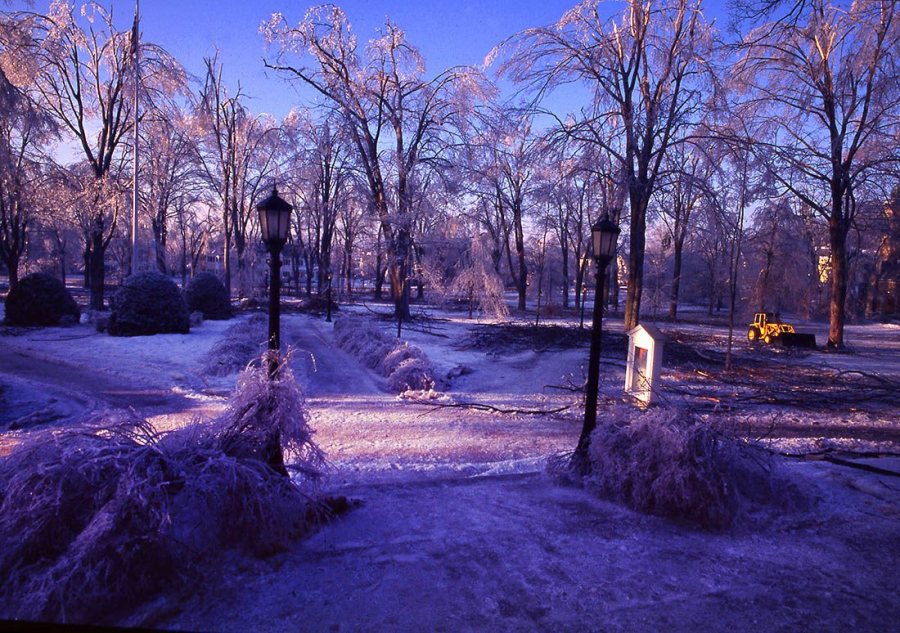
As sunshine returned to Bates on Jan. 11, 1998, heavy equipment took to the Historic Quad to begin the cleanup.
In darkened Canham House, history professor Michael Jones welcomed his students for an apropos discussion of the decline of the Roman Empire. Holding the lantern up to the blackboard, Jones said he “felt like Diogenes.”
In the English department, Rob Farnsworth (13 and a half days without power) gained insight into Wordsworth’s poetry that you can’t find in CliffsNotes. Staying with friends after he and his family fled their cold home, he lived and taught out of a small bag for two weeks.
“Perhaps all of the history of the world before electricity and central heating was a fabrication.”
About a week into his “disorienting and disheveling experience,” Farnsworth and his Romantic poetry class were discussing Wordsworth’s early poems about mendicants and mad people. “And it dawned on me. I had become the old Cumberland beggar“: “Bow-bent, his eyes for ever on the ground, / He plies his weary journey.”
Farnsworth wasn’t the only person reflecting on his altered state of being, not to mention a growing sense that anyone preaching asceticism could take the concept and, well, shove it.
Seated at his fireplace, Dean of the College Jim Carignan ’61 tried reading Ben Franklin by candlelight. He not only wondered whether anything productive could be done in those circumstances, but “I began to think that perhaps all of the history of the world before electricity and central heating was a fabrication.”
In nearby South Paris, 25 trees fell across the driveway of Dyk Eusden ’80, associate professor of geology. The National Guard and neighbors helped clear the debris, and as Eusden got familiar with hundreds of snapped trunks and limbs, an idea flashed in his mind — brittle deformation! Not as poetic as “Eureka!” but Eusden noticed how the shattered wood illustrated a geologic concept describing how the earth’s crust fractures.
“You expect a storm to go on at night and then end. But the length of this storm was overwhelming.”
“I now have about three chainsawed tree trunks from the ice storm that I use every year in my classes to demonstrate brittle deformation,” Eusden says. “I cut them so each has a right angle bend preserved with lots of splintered wood.”
The grimmest looking person on campus during the ice storm had to be Bergevin, caretaker of Bates flora, who could be seen striding across the limb-strewn Quad during the worst of it Thursday and Friday, when 1.8 inches of freezing rain fell on top of Wednesday’s half-inch.
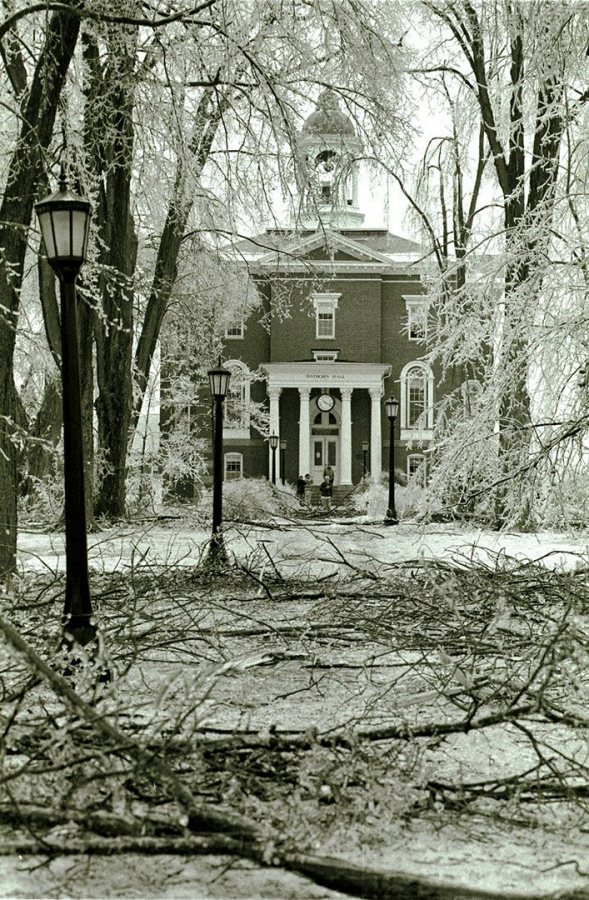
This iconic perspective on Hathorn Hall took on a chaotic feel during the ice storm of January 1998.
With ax in hand and an expression of foreboding, he wasn’t far removed from a casting call for The Shining. “Limbs just kept on falling and falling and falling,” he remembers. “At night, you heard the snapping, crashing, banging of limbs. You expect a storm to go on at night and then end. But the length of this storm was overwhelming.”
Like any major weather phenomenon, extreme factors combined to create the epic event. In January 1998, an unusually strong fetch of tropical moisture sliced into very cold air. The result was a warm-air sandwich in the atmosphere, says Colin Marquis ’92, former on-air meteorologist for the Weather Channel.
“In an ice storm, it’s below freezing at the surface and way up high in the atmosphere,” Marquis explains. “But in the middle, several thousand feet up, there’s an intrusion of above-freezing air.”
Meteorologists and weather buffs tend to get giddy at the prospect of meteorological mayhem, but the prospect of an ice storm, even an awesome ice display like 1998, leaves even them cold.
“Meteorologists go crazy over the power of atmosphere. That’s not what an ice storm is about.”
Compared to ice storms, snowy northeasters are more thrilling, tornadoes can transport Dorothy to a magical land, and hurricanes incite meteorologists to linger over satellite images, speaking lovingly of outflow patterns and eye walls.
Marquis, a New England native who got hooked on weather during the great Blizzard of ’78, suggests the lack of excitement is because an ice storm is often “a transient thing” between rain and snow. An ice storm doesn’t fit the category of “wild weather” that captivates a meteorologist’s imagination. An ice storm is an imperfect storm, one that can’t decide its identity — snow or rainstorm. “You kind of have to put an asterisk next to any ice storm,” says Marquis. “Meteorologists go crazy over the power of atmosphere. That’s not what an ice storm is about.”
Back in 1998, the sun reappeared on Saturday, Jan. 11, and Bergevin’s gloom lifted a bit. “It stopped, and you looked and saw that the trees were still there,” he said. “It was amazing that they had survived.” Limbs littered the Quad, and the treetops looked like a very large, very dull scythe had whacked them all. Well into the following weeks cherry pickers from Whitney Tree Service roamed the Quad. Every jagged break on every tree had to be trimmed back to solid wood.
Even then, the prognosis wasn’t good.
“Some of the guys from the tree company thought the shock to the damaged trees would be too great, that they would just continue to go downhill and die,” Bergevin remembers. “Spring came, and you held your breath and hoped for the best. And it came.”
“It just wanted to live. So you have to respect it. You have to let it stay.”
The trees rebounded (though observers remember Commencement 1998 being the lightest and brightest in memory, fewer limbs offering few shade leaves).
To Bergevin’s surprise, the mature trees have even sprouted new growth in recent years. The maple between Hathorn and Dana Chemistry, for example, took a beating in the storm and afterwards looked like a gaunt, shell-shocked war veteran. But even this tree shows new growth.
“You feel sort of sorry for it, the way it just sits there,” Bergevin says on a windy November morning, gazing up at the maple from a sunny spot near Hathorn. “Why it puts out new growth is beyond me, but it just wanted to live. So you have to respect it. You have to let it stay.”
Still, reminders of the ice storm lurk around campus, startling anyone who, as Bergevin says, hopes the storm was “one of those once-in-a-lifetime events.” Last summer, for example, a few apparently healthy limbs fell from campus trees. “I said to myself, ‘What the heck?'” Bergevin recalls.
He examined them and realized each had been cracked by the ice storm, but not enough to bring them down in 1998. After several years of new growth and new leaves, the added weight finally doomed the injured limb. “I’m sure we’ll find a few others over the next few years that will do the same thing.”
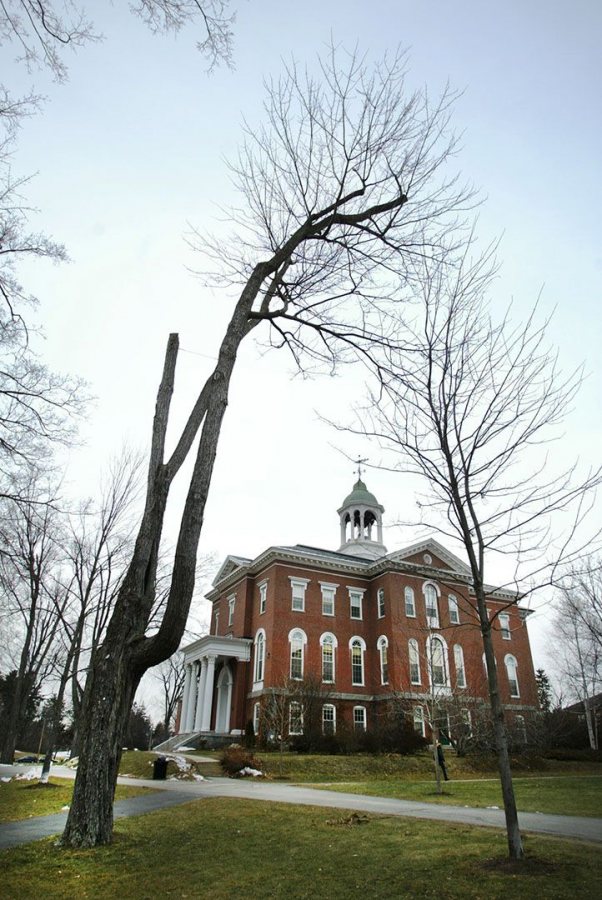
Five years after the storm, in November 2003, one of the hardest-hit trees on the Historic Quad was sprouting new growth at its tips.
Another outgrowth of the ice storm was, for the first time, college policy to deal with extreme events like the ice storm. The policy gives professors the discretion to cancel a class during a weather emergency and includes provisions for closing administrative offices during a weather emergency.
On Jan. 9, 1998, the Friday morning of the storm, Admissions staffers Adam Garcia ’92 and Dean Jacoby ’93 arrived at Lindholm House, which was cold and dark like the rest of Bates, the rest of Maine, and most of Quebec. They lived nearby on Webster Street, so it was an easy walk, but many of their colleagues lived in ice-torn hinterlands.
“We were the only ones to show up,” Jacoby says. He and Garcia got some sweaters, broke out a cribbage board, and began to enjoy a rare quiet day in Admissions.
But the quiet didn’t last long, as cars bearing Connecticut, New Jersey, and Massachusetts plates began arriving outside. Though Maine Gov. Angus King had declared a state of emergency, that news didn’t get to parents from away who were determined to keep their children’s interview appointments.
“People started pouring in,” Jacoby says, “and they all wanted to know what was going on, why the lights were out, how it looked like we were closed.”
One family was upset there were no tours. (At the time, there were signs posted all around the campus: “DANGER FALLING LIMBS. DO NOT USE MAIN QUAD.”)
“So the day,” Jacoby remembers, “just went on.”
